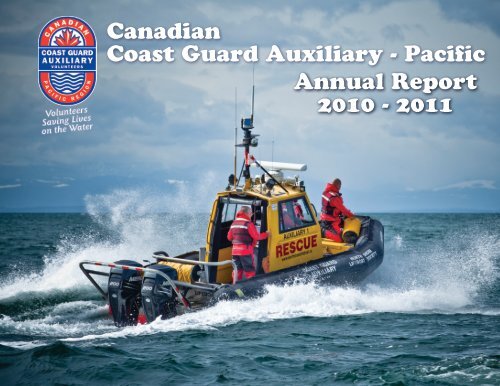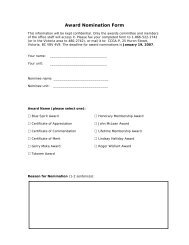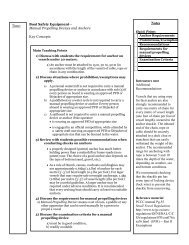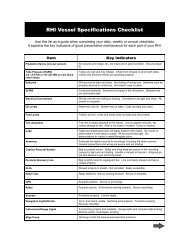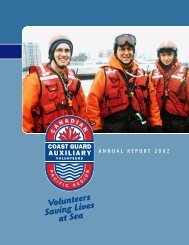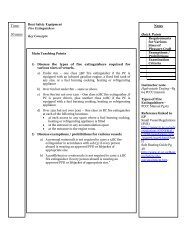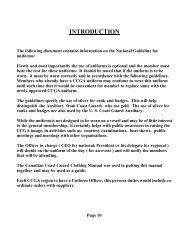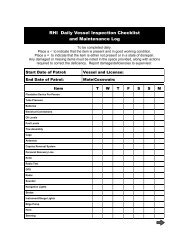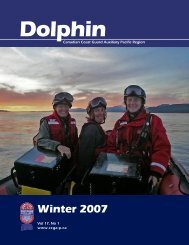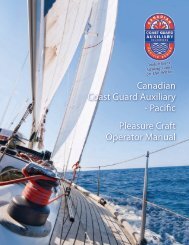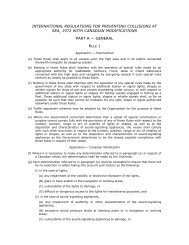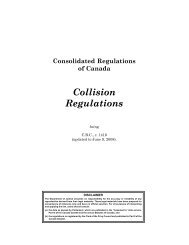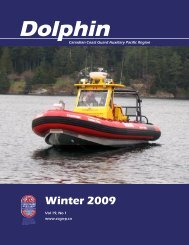Annual Report 2010 - 2011 Canadian Coast Guard Auxiliary - Pacific
Annual Report 2010 - 2011 Canadian Coast Guard Auxiliary - Pacific
Annual Report 2010 - 2011 Canadian Coast Guard Auxiliary - Pacific
Create successful ePaper yourself
Turn your PDF publications into a flip-book with our unique Google optimized e-Paper software.
<strong>Canadian</strong> <strong>Canadian</strong> <strong>Coast</strong> <strong>Guard</strong><strong>Coast</strong> <strong>Auxiliary</strong>- <strong>Guard</strong> <strong>Auxiliary</strong> <strong>Pacific</strong> - <strong>Pacific</strong><strong>Annual</strong> <strong>Report</strong><strong>2010</strong> - <strong>2011</strong><strong>Annual</strong> <strong>Report</strong> 2009-<strong>2010</strong>
team is well on their way todesigning our new Type 1 boat.Input has been solicited fromstations across the Region and acommittee of members teamingup with a naval architectis working hard to developanother successful project.I know in a few years theseaccomplishments will fade intomemory and simply become anew standard for us that we justcome to expect, but hopefully wenever forget what a big step thiswas.Simulator – As per above, thesuccess of building this projectalready starts to slip into ourhistory section. The highlight forthis year is the extreme interestwe are receiving from agenciesaround the world with regard toattending our simulator and/orcopying our success and buildingsimilar programs elsewhere.Imitation is the greatest form offlattery which certainly wasn’tour goal, but it does validate thework of those in the programand the rest of us who use iteach year.Communication – Last yearmarked the launch of our‘Compass’ online magazinethat we publish each month.This has truly been a greattool for increasing the levelof information that we canshare with members. Whetherit is standards, training itemsor simply good stories, thiscommunication has helped usreduce the communication gap.Furthermore, the CCGA-PBoard has visited many stationsand met many members face toface through a series of townhall meetings to present thevision for our future and outlaythe challenges we face.The CCGA-P joined the 21stcentury with a Facebook pageset up and maintained by someof our more tech savvy membersto further inform members ofhappenings around the region.I hope that we can continueto build upon this success andfurther engage the members indiscussions through these andother forums.The success stories are easyto tell but the challenges weface are just as important tonote. Going forward, we needto continue to focus on a fewkey areas in order for us to notonly to advance but to maintainthe levels of performance wecurrently enjoy. In particular, weneed to work on the following:Funding – The ability to obtainfunding has and always will be akey challenge for us. We are trulygoing to reach a roadblock indevelopment and/or operationof this organization in the futureif we can’t find more sources offunding. Inflation alone createsenough pressure but we alsohave needs for increased levelsof training, new stations, fleetrenewal and maintenance toname a few.Standards – We have spenta significant amount of timeand resources, and obtainedcommitment from mostmembers with our standards.Now it is really important thatwe continue to communicatethese standards to existing andnew members and also to ensurethat we all follow them. Whetherit is certifications, sea time, ortimely reporting, the safety ofour crews and success of thisorganization lies directly on themembers.We participate in an inherentlyrisky business and it isCCGA-P <strong>Annual</strong> <strong>Report</strong> <strong>2010</strong>/<strong>2011</strong> 3
extremely important that wefollow the procedures, policiesand standards in place to ensurewe mitigate and reduce theserisks to an acceptable level. Eachof us has a key role to play.Leadership – It has beensaid before many times, thisorganization has got to whereit is due to strong leadershipat all levels, whether it beTraining Officers, StationLeaders, Management Team, orBoard Members. We need toensure that we are continuingto develop future leaders inour stations, not only for thesuccessful operation of eachlocal station but also for theorganization as a whole.I believe strongly in the BoardGovernance model wherebyterm limits are set and constantrecruiting takes place. Certainlyit has been structured so that wemaintain a balance of experiencethrough each successive boardbut the benefit of constantlyrenewing any group cannotbe overstated. New ideas andenergy replace stagnant or tiringmeetings.Similar philosophies shouldapply at all of our stations.Newer members need to begiven responsibility early on sothey can develop and grow intoroles such as training officers,station leaders, or perhaps amanager or board member.I am going to be repetitivehere. It is essential that I onceagain take the space to thank themany people and organizationswho truly make all we dopossible. In particular, I mustthank the following:qqOur Volunteers: These menand women take time awayfrom family, work and lifeto train, rescue, educate,and administer for ourorganization.q Our Families: These truly unsungheroes are the ones often leftbehind.qqBritish ColumbiaGovernment GamingBranch: The staff at theGaming Branch has alwaysrecognized the importanceof having our crews inappropriate safety gearand vessels and withouttheir continued supportthis organization would begreatly hindered.qq<strong>Coast</strong> <strong>Guard</strong>: They havepushed us to achieve higherstandards in training, safety,and vessel design with thesole intent of ensuring ourcrews are able to safely carryout every mission we aretasked to.qqSponsors: This group hasrecognized that a strongmarine rescue presenceacross the region is of vitalimportance to each of us.qqEmployees: They are multitasking, hard working,forward thinking individualswho give much more to theorganization than wouldnormally be expected.While I was duly warned, Ihave to admit that this volunteerrole is more demanding,stressful, and tougher than Icould have imagined but atthe same time it is extremelyrewarding.It truly is a pleasure andhonour to serve the members ofthis organization as well as themembers of our community.Randy StrandtCCGA-P President4 CCGA-P <strong>Annual</strong> <strong>Report</strong> <strong>2010</strong>/<strong>2011</strong>
Overall, taskings weredown in <strong>2010</strong>-11 fromthe previous year by17%, with some stations seeingdrops by as much as 76%, butsome stations seeing increasesof up to 50%.StatisticsThe faltering economy and areduction in boater traffic seemsto be the major factor for theoverall decline. Aux. 27 and 36led the pack with 93 and 57missions respectively.The fiscal year started out withone of the busiest days on recordwith the Joint Rescue Centre(JRCC) recording more than 40calls during the Easter stormof April 2nd, <strong>2010</strong>. Stationsthroughout the Strait of Georgia,Gulf islands and Victoria areawere busy.RESCUE SPOTLIGHTDuring the April 2nd storm, CCGA-P crews were taskedto a number of calls related to the Southern Straits YachtRace, including at least one broken boom, one vesseldismasted and another sailboat sinking, putting five crewin the water. With winds gusting over 50 knots, most of thecompetitors dropped out but enough hung in to providea busy afternoon for SAR resources when things startedto go wrong. <strong>Auxiliary</strong> 27 Nanaimo was called to assistthe 38-foot sailing vessel Radiance, dismasted six milesnortheast of Entrance Island. Arriving on scene, threemiles from the original position, Aux 27 was about to takeRadiance under tow when they were retasked to the sailingvessel Incisor, which was sinking with five persons inthe water. The hovercraft Penac managed to recover allfive crew of the Incisor, and Aux 27 was retasked to theRadiance, towing and ultimately securing the dismastedvessel. All of this was going on with winds well over 45knots and seas reaching 15 feet, which greatly hamperedradio communications as well as damaging vessels andequipment.CCGA-P crews can take pride in the fact that they playeda major part in ensuring that no lives were lost and twovessels were towed to safety in one of the most violentstorms in Georgia Strait in recent memory.POLICY CHANGESDiscussions between CCGA-P,commercial assist operators, the<strong>Canadian</strong> <strong>Coast</strong> <strong>Guard</strong> (CCG),MCTS and the Joint RescueCoordination Centre (JRCC)resulted in a modified towingpolicy being released which allCCG and CCGA stations mustnow adhere to. In short, thispolicy states that CCG andCCGA are not in the businessof towing, and that unless lifeis at risk, wherever possibleand practicable, commercialassistance should be used totow vessels to safety. CCGA-Presources are required torelinquish a tow, shouldcommercial assistance comeon scene.Special Events, SAR Patrols andGuest authorizations and howthey could be applied to societyfund-raising events withoutviolating the constraints of ourCCGA-P <strong>Annual</strong> <strong>Report</strong> <strong>2010</strong>/<strong>2011</strong> 5
commercial licensing restrictionswas a hot topic for most of theyear. Some resolution of thisissue has occurred in fiscal year<strong>2011</strong>-12.SAR MISSION FREQUENCY BY MONTH <strong>2010</strong>-<strong>2011</strong>THANK YOUSAfter several years ofdedicated service as Managerof SAR Operations, DavidRees-Thomas retired from theposition in February of <strong>2011</strong>and Rob Grant of Station 8 -Delta, was appointed as hisreplacement. Many thanks toDavid for his time, dedicationand leadership throughout theyears.As always, the invaluableassistance of Bob McCauley whoreviews the SAR incident claims– a huge job – is very muchappreciated.CAUSES OF SAR INCIDENTS <strong>2010</strong>-<strong>2011</strong>6 CCGA-P <strong>Annual</strong> <strong>Report</strong> <strong>2010</strong>/<strong>2011</strong>
Every CCGA-P stationnow has an activeboating safety program.The CCGA-P Boating Safetyprogram has many differentaspects including Kids Don’tFloat Boards, Pleasure CraftCourtesy Checks, PleasureCraft Operator Cards, BoatingSafety Education for childrenand Boating Safety Displays. Inaddition, there are five stationsdedicated solely to boatingsafety.Kids Don’t FloatThe <strong>Canadian</strong> <strong>Coast</strong> <strong>Guard</strong><strong>Auxiliary</strong> –<strong>Pacific</strong> now has 30Kids Don’t Float boards in busymarinas and beaches throughoutthe province.The CCGA-P has been offeringthis program since 2003 andits success lies in its simplicity:Kids Don’t Float Boards are an integral part of the CCGA-P BoatingSafety program.Photo: Aaron Frost.supply loaner PFDs to children.The CCGA-P would not be ableto offer this program throughoutthe province without thecontinued support of MustangSurvival. Mustang providesvarious children–sized PFDs forall of our boards throughout theRegion.The CCGA-P continues tocollaborate with local RCMPdetachments, municipalities andmarinas to provide Kids Don’tFloat boards in areas wherethere is not a CCGA-P station.Pleasure CraftSafety ChecksThanks to the diligent workof Ken Morisette, <strong>2010</strong>-<strong>2011</strong>was another successful year forPleasure Craft Safety Checks.Morisette oversees the PleasureCraft Safety Check (PCSC)program and administers theCCGA-P <strong>Annual</strong> <strong>Report</strong> <strong>2010</strong>/<strong>2011</strong> 7
PCSC Course for members whowant to deliver PCSCs to thepublic. There are currently 90members trained to conductPCSCs. This past season, CCGA-Pmembers conducted over 800PCSCs throughout the province.Pleasure CraftOperator CardThe <strong>2010</strong>-<strong>2011</strong> year sawTransport Canada overhaulthe Pleasure Craft OperatorCard program. The new examis tougher and has stricteradministrative procedures toensure the validity of all testsand course providers. CCGA-PTraining Manager, Dan Robinson,worked with Transport Canadathroughout the year to createa PCOC Manual that meets thenew, tougher criteria.In the next fiscal year, theCCGA-P will publish the newTransport Canada approvedPCOC Manual as well as the newadministration procedures forstations wishing to offer PCOCcourses to new members andthe public.Future DirectionsBoating Safety remains apriority for the CCGA-P. In theupcoming year, the CCGA-Pwill finalize plans to beginSAR patrols and on-the-waterPCSCs on the Interior lakes. TheCCGA-P will also endeavor toimplement a revamped PCOCprogram that can be easilyadministered at the station level.Boating Safetyby the Numbers<strong>2010</strong>-<strong>2011</strong>:Displays, Parades 88Community Events 95Member Hours 3,515.5Crewmembers from Station 5Crescent Beach teach a local Beavertroop about water safety.Photo: Steve Somerville.8 CCGA-P <strong>Annual</strong> <strong>Report</strong> <strong>2010</strong>/<strong>2011</strong>
We have made a lot ofprogress over thepast couple of yearswith regards to standardizationof our fleet of vessels and theequipment being used. A largepart of this progress has beendue to support being receivedat the station level towards thismovement.Standardization results in amore efficient system, whereequipment issues can be dealtwith and the same messagebeing sent to everyone, ratherthan having multiple stationswith a varying degree of issues.Eventually our vessels will becompletely standardized whichwill result in more consistenttraining and greater safety foreveryone.We have also met as aManagement Team and createda 10 year plan for vessel, engine,The first Falkins Class Type II vessel was launched in January <strong>2011</strong>.Photo: Gordie Robinson.and electronics replacement aswell as proposed dates for vesselre-fits.This process although only in adraft form, will be very helpful inlong0term planning. It will helpus in a proper planning processand working with stations toensure we are looking into thefuture and allowing enough timefor the stations to acquire thefunding needed.CCGA-P Type II VesselSince the last report we havelaunched the first two of theCCGA-P Type II Vessels. Thefirst was the inboard dieseljet version in Nanaimo inJanuary, and the second wasthe Yamaha outboard versionfor Port Alberni in April. Bothhave certainly lived up to ourexpectations as being one of thebest SAR vessels constructed inthe CCGA.We have contracts in place forthe construction of three moreType II vessels all of which willbe diesel jet versions.The first will be for PrinceRupert and is well underwaywith the completion set for thefall of <strong>2011</strong> with the next two forthe North Shore Marine RescueSociety to follow immediatelyafter.We also have three additionalstations who have expressedan interest in the Type II andCCGA-P <strong>Annual</strong> <strong>Report</strong> <strong>2010</strong>/<strong>2011</strong> 9
will likely have contractsin place for construction in2012/2013.CCGA-P Type I VesselWork is almost completeon the design of the Type Iwith drawings scheduled forcompletion in September<strong>2011</strong>. The vessel will be aRHIB design under 9 metresand has been designedto meet high standardsestablished by the CCGA-Pfor Lloyd’s Registry, ISO,and Transport Canada. Thedesign committee has put alot of thought into the vesseland hopes to present thesedrawings to potential buildersby year-end.EquipmentWe are continuing tostandardize the equipmentPreliminary rendering of the CCGA-P Type I vessel.onboard our vessels. Stationsare now starting to contact theVessel and Equipment StandardsManager prior to any purchases.This has been very helpful as itallows us to work together toensure the correct equipmentis purchased. One of the largeissues we have is the variety ofpersonal equipment being used.As we move forward with there-branding of the CCGA-P, thiswill allow us to set out somestandards with regards to newpersonal equipment such asPFD’s, cruiser suitsThe plan is to establish amore standardized look forour members so that we canbe more recognizable.EnginesWe have only a fewremaining stations withengines other than Yamaha,and as time goes on we willwork to have these replaced.This has been working outwell and we have a verygood relationship withYamaha. This makes it aneasier task working withone manufacturer to resolveissues.We continue to remind ourstations of the CCGA-P policy onengine replacement and that theCCGA-P requires stations ensurethat the engines have have therequired minimum hours onthem prior to replacement.10 CCGA-P <strong>Annual</strong> <strong>Report</strong> <strong>2010</strong>/<strong>2011</strong>
The CCGA-P has continuedtraining in many formsto the stations so thatrescue vessel crews are readyto respond to and properlyassess the risks involved withsearch and rescue missions inpoor and sometimes hazardousconditions.The provision of TransportCanada-certified courses ofSimulated Electronic Navigation- Limited (SEN L), Small VesselOperator Proficiency (SVOP) andMarine Emergency Duties A3(MED A3) to our members havecontinued.A further 11 members wereadded to the Advanced RescueTrainer/ Evaluator team.Two station leaders traveledto Europe to spend a coupleof days with the KNRM in theNetherlands, before attendingthe International CoxswainsCourse in Scotland. The twoattendees appreciated the visit,as it allowed them to see howthey are part of the worldwidemarine search and rescueorganization. The coxswainswill continue to share theirexperiences with their stationsand the region.Many stations have set upSAR exercises, both for theirown and neighbouring stations.A <strong>Canadian</strong> <strong>Coast</strong> <strong>Guard</strong> ledexercise centred around theevacuation of a B.C. ferry, washeld in Nanaimo in April <strong>2010</strong> inwhich two stations participated.Other stations have been ableto train with the Cormoranthelicopters of 442 Squadron.FAST RESCUE CRAFTSIMULATORThe Fast Rescue CraftSimulator has continued to bea cornerstone for training overthe past year. The benefits of theUpgraded Transas software in the Simulator makes the scenarioseven more realistic.updated software from Transashas been appreciated by allattendees. During <strong>2010</strong>-<strong>2011</strong>, 53members successfully completedSARnav 1 courses, and 32 passedSARnav 2. SARnav-1 is aimedat experienced crew, allowingCCGA-P <strong>Annual</strong> <strong>Report</strong> <strong>2010</strong>/<strong>2011</strong> 11
TRAINING HOURS BY MONTH <strong>2010</strong>-<strong>2011</strong>them to properly supporttheir coxswain. Participantswho successfully complete thecourse also receive TransportCanada Small Vessel OperatorProficiency (SVOP) certification.The SARnav-2 course is aimedat coxswains and teaches themsafe operation and navigationin restricted visibility. Studentswho successfully completeSarnav-2 receive TransportCanada Simulated ElectronicNavigation – Limited (SEN-L)certification.The simulator is also usedto provide extra electronicnavigational training, oftenfor a group from a station toattend together, allowing a fullcrew to hone their skills ofworking together as a team, andrefining their crew resourcemanagement skills. It is alsoused for instrument buttonologycourses, as well as day-longrefresher courses for membersneeding more practice with thesimulator and on-the-water.TRAINING TOOLSThe majority of the CCGA-P’s training is done at thestation level. On-the-water andclassroom training is typicallyoverseen by the Station TrainingOfficer, who receives guidancefrom the regional training staff.The CCGA-P continues to use:qqSAR Learning System(SLS) which allows membersat all stations to improvetheir knowledge of electronicnavigational aids at home. ANIF Grant has been obtainedto develop a more advancedsystem, including onlinesimulation, that is aimed to beavailable in 2013.qqOnline Materials: Alarge selection of materials,12 CCGA-P <strong>Annual</strong> <strong>Report</strong> <strong>2010</strong>/<strong>2011</strong>
updated at intervals, is availableonline on the CCGA-P websiteto support local on-water andclass-room training.SAFETY MANAGEMENTThe CCGA-P’s SafetyManagement System (SMS)continues to evolve providingoperational and safety guidancefor all members of the CCGA-P.The purpose of these proceduresis to ensure the safety of all crewmembers when they are out onthe water.A more robust and timelysystem of accident reporting andinvestigation is being broughtin, so that all the lessons can belearned, and the appropriatecorrective action gets taken tominimize the chance of thathappening again at that stationas well as allowing our stationsto benefit from the experience.A second round of auditswere conducted by the SafetyManagement Officer, furtherlooking into procedures, whileat the same time providingongoing training and evaluationsas required at each station.Particularly important is theconsistency of pre-RHIOTevaluations, which allowsRHIOT candidates to attend therestricted number of seats atthis much sought-after <strong>Canadian</strong><strong>Coast</strong> <strong>Guard</strong> course at Bamfield,and provide them with thegreatest chance of passing.JET BOAT TRAININGWith the introduction of thesecond water jet propelledvessel in Nanaimo, a rigoroustraining regime was set up sothat all coxswains were totallyfamiliar with the operations ofsuch a vessel, and that coxswainand crews were totally familiarwith the vessel, its capabilitiesand systems.This work by the Nanaimostation will greatly assist otherstations that will purchasethe Type II, in getting theircoxswains and crews up tospeed.FUTURE DIRECTIONSTraining will remain a highpriority for the CCGA-P for the<strong>2011</strong>/2012 year, to allow crewsto operate at their best, andproperly reduce the risk as muchas possible.Work will continue on theestablishment of a CCGA-Ptraining institute that will allowfor centralized on-water andclassroom training, and act asa home base for the CCGA-Phead office and the simulatorprogram.A reduction in the numberof RHIOT seats is severelyrestricting the ability of stationsto respond, 24/7. The CCGA-Phas an insufficient numbersof coxswains which leads tocoxswain burn out, or periodsof stations standing down. TheCCGA-P is seriously looking atalternatives to this course whichwill allow the certification of ourown coxswains.A network of qualifiedinstructors in both TransportCanada certified and basiccourses is being developed toprovide local support to stations.In <strong>2011</strong>/12, the CCGA-P willpromote training as beingimportant to manage risk onall our vessels, by having highlytrained and motivated crews.CCGA-P <strong>Annual</strong> <strong>Report</strong> <strong>2010</strong>/<strong>2011</strong> 13
AprilThe April 2nd storms resultsin one of the busiest days inCCGA-P history. JRCC reportedalmost 40 calls. CCGA-P crewsfrom Nanaimo, Ladysmith, MillBay, Halfmoon Bay, Gibsons,Saanich, Victoria and Oak Baywere all called on multiple timesto assist boaters in distress.MayA CCGA-P Station 27 Nanaimocrew came to the rescue of22 people after their dragonboat capsized on May 2. Theskipper of their chase boatinadvertently gunned hisengines, which swamped thedragon boat. All 22 passengersended up in the freezing waters.The CCGA-P crew worked withthe chase boat, and a vesselof opportunity to retrieveeveryone and transport them totheir boathouse for assessment.Crewmembers from Station 1, Howe Sound helped rescue adiver in August <strong>2010</strong>.JuneCCGA-P Station 75 Kincolithhad its first call on June 21stwhen they received a Maydaycall from a 32-foot bowpicker.Once they arrived on scenethey found the vessel in tow byanother rescue vessel and Aux75 monitored the situation onbehalf of Prince Rupert <strong>Coast</strong><strong>Guard</strong> Radio.JulyThe quick actions of aCCGA-P Station 37 Sooke crewmost likely saved the life of anAmerican tourist attemptingto swim across Sooke Channel.The swimmer had been in thewater for over 30 minuteswhen the crew arrived andshowed signs of hypothermia.Once aboard, the swimmerwas nearly incoherent andshivering uncontrollably. Thecrew administered treatmentand once ashore, transferredthe patient to an awaitingambulance.AugustA diver-recovery trainingexercise turned into a rescuemission for a CCGA-P Station 1Howe Sound crew when a diverfailed to resurface near WestVancouver’s Whytecliff Park onthe morning of August 22. Thecrew arrived on scene in eightminutes to find the diver in thewater unconscious. The crewprovided CPR on the short runinto the beach where the localfiremen then took over. Thevictim was then transported tohospital in critical condition.14 CCGA-P <strong>Annual</strong> <strong>Report</strong> <strong>2010</strong>/<strong>2011</strong>
SeptemberA CCGA-P Station 14 Gibsonscrew saw a flashlight waving ontheir way back from a trainingexercise. They found threepeople whose vessel struck adeadhead and was sinking. Avessel of opportunity quicklyrecovered everyone and once<strong>Auxiliary</strong> 14 was on-scene theywere transferred to their vesselfor first aid assessment. Thepassengers were then takenashore to awaiting paramedics.OctoberA seriously injured hiker wasrescued from the CowichanBay area during a multi-agencyrescue involving CCGA-P Station34 Mill Bay. On November14 Station 34 assisted localfirefighters, a land SAR crew and<strong>Coast</strong> <strong>Guard</strong> with the evacuationof a female hiker with a crushedchest and a broken femur.Station 63 Kitimat particpated in a marathon serach for a Manoverboard off the Northern Victor (above) in January.DecemberOn December 3, CCGA-PStation 20 Salish Seas investigateda report of a vesselstriking the breakwater at thePort Browning marina. Onceon-scene the crew observed agrey dinghy capsized and tied tothe dock. After conducting someinterviews, they determined thata neighbor had recovered thedinghy owner and the dinghywith fuel intact. The crewreported their findings to MCTSand returned to base.JanuaryCCGA-P Station 63 Kitimat tookpart in a marathon 12.5-hoursearch after a man overboardwas reported from a nearby fishprocessing ship. The CCGA-PKitimat crew, along with <strong>Coast</strong><strong>Guard</strong> vessel and a <strong>Canadian</strong>Forces Cormorant searched forthe person to no avail.FebruaryCCGA-P Station 35 Victoria,came to the aid of a disabledmilitary vessel recently, rescuingtwo officers who had beendrifting for three hours. OnFebruary 4, three vessels fromCFB Esquimalt had been outtraining when one lost contact.The disabled vessel was spottedby the Victoria Clipper ferry andStation 35 was tasked to tow thevessel back to its base.MarchOn March 26th CCGA-P Station2 Indian Arm joined <strong>Coast</strong> <strong>Guard</strong>and RCMP in the search. for amissing kayaker <strong>Coast</strong> <strong>Guard</strong>recovered the victim from thewater and performed CPR on theunresponsive victim while theCCGA-P crew cleared the publicwharf so the <strong>Coast</strong> <strong>Guard</strong> andRCMP vessels could dock. Thecrew then liasioned with localfire and ambulance personnelwho continued to work on thevictim for another 40 minutes.Sadly, the victim could not berevived.CCGA-P <strong>Annual</strong> <strong>Report</strong> <strong>2010</strong>/<strong>2011</strong> 15
It’s been an excitingyear in marketing andpromotions for the CCGA-P.Port McNeill reopened as aCCGA-P station with a newgroup of vibrant and dedicatedvolunteers.In March <strong>2011</strong>, the <strong>Canadian</strong><strong>Coast</strong> <strong>Guard</strong> <strong>Auxiliary</strong> becamethe only <strong>Canadian</strong> Charitylisted as a beneficiary onPrince William and KatherineMiddleton’s Royal Gift Fund,which encouraged well-wishersto make donations to charitieshand-picked by the couple inlieu of gifts.This provided a massiveamount of public exposure forour organization in addition tothe many donations that werecollected, which included adonation of $50,000 from the<strong>Canadian</strong> Government.The CCGA-P joined theworld of social media with theadoption of a Facebook page inJanuary. The page allows fansto post photos, missions andrelevant information for othervolunteers and members of thepublic. The page has been wellreceivedand sparked interestfrom many of our communitybasedstations to start their ownFacebook pages. As the generalpublic becomes more aware ofthis page, our public profile willcontinue to rise. Our intentionswill be to continue expanding toother social media resources aswell.FUNDRAISING<strong>2010</strong>-<strong>2011</strong> was a successfulfundraising year for the CCGA-P.Our major supporter continuesto be the B.C. Gaming Policyand Enforcement Branch, whichapproved $1.28 million in fundsfor our stations last year. TheCCGA-P also received hundredsof donations as a result oftwo direct mail fundraisingcampaigns this year, one in thesummer and one in the winter.The CCGA-P is gearing up tofocus on a capital campaignin the next fiscal year. Thiscampaign will focus on securingfunding for a new regionalheadquarters that will include atraining centre.Our individual stations andtheir supporting societiescontinue to work diligently intheir communities to securefunding.Station 4 Squamish created aunique fundraising campaign inAugust <strong>2010</strong> with a Duck Racein the Mamquam River wherepeople purchased rubber ducksthat were dropped into the rivervia helicopter and raced downthe river for prizes.Station 5 Crescent Beachcontinues to solicit a steadystream of corporate and privatedonations through their verysuccessful Golf for VigilantTournament and annual Trooperconcert.Also this year, Station 64Prince Rupert received muchneededfunding for theirnew vessel during a long andconcentrated blitz of face-to-facebusiness solicitations.Fundraising in the northernregion is extremely difficultand the team in Prince Rupertshould be commended for theirdiligence and hard work in theircampaign. Congratulations toall stations on their successfulfundraising initiatives this year!16 CCGA-P <strong>Annual</strong> <strong>Report</strong> <strong>2010</strong>/<strong>2011</strong>
FUTURE DIRECTIONSThe CCGA-P will continue therebranding process. The needfor rebranding is evident to mostespecially those who have triedfundraising under our currentmoniker. The next chapterfor the CCGA-P will includeconsulting with the membershipand implementing our new lookthroughout the Region.CCGA-P crewmembers gavetours of the new Falkins TypeII vessel at the Vancouver BoatShow in February <strong>2011</strong>.Photo: GordieRobinson.CCGA-P <strong>Annual</strong> <strong>Report</strong> <strong>2010</strong>/<strong>2011</strong> 17
INDEPENDENT AUDITOR'S REPORTTo the Members of <strong>Canadian</strong> <strong>Coast</strong> <strong>Guard</strong> <strong>Auxiliary</strong> (<strong>Pacific</strong>) Inc.We have audited the accompanying financial statements of <strong>Canadian</strong> <strong>Coast</strong> <strong>Guard</strong> <strong>Auxiliary</strong> (<strong>Pacific</strong>) Inc., which comprise the statement offinancial position as at March 31, <strong>2011</strong>, and the statements of operations and changes in net assets and cash flow for the year then ended, and asummary of significant accounting policies and other explanatory information.Management's Responsibility for the Financial StatementsManagement is responsible for the preparation and fair presentation of these financial statements in accordance with <strong>Canadian</strong> generallyaccepted accounting principles, and for such internal control as management determines is necessary to enable the preparation of financialstatements that are free from material misstatement, whether due to fraud or error.Auditor's ResponsibilityOur responsibility is to express an opinion on these financial statements based on our audit. We conducted our audit in accordance with<strong>Canadian</strong> generally accepted auditing standards. Those standards require that we comply with ethical requirements and plan and perform theaudit to obtain reasonable assurance about whether the financial statements are free from material misstatement.An audit involves performing procedures to obtain audit evidence about the amounts and disclosures in the financial statements. The proceduresselected depend on the auditor's judgment, including the assessment of the risks of material misstatement of the financial statements, whetherdue to fraud or error. In making those risk assessments, the auditor considers internal control relevant to the entity's preparation and fairpresentation of the financial statements in order to design audit procedures that are appropriate in the circumstances, but not for the purpose ofexpressing an opinion on the effectiveness of the entity's internal control. An audit also includes evaluating the appropriateness of accountingpolicies used and the reasonableness of accounting estimates made by management, as well as evaluating the overall presentation of thefinancial statements.(continues)18 CCGA-P <strong>Annual</strong> <strong>Report</strong> <strong>2010</strong>/<strong>2011</strong>1
Independent Auditor's <strong>Report</strong> to the Members of <strong>Canadian</strong> <strong>Coast</strong> <strong>Guard</strong> <strong>Auxiliary</strong> (<strong>Pacific</strong>) Inc. (continued)We believe that the audit evidence we have obtained is sufficient and appropriate to provide a basis for our qualified audit opinion.Basis for Qualified OpinionAs described in Note 2, the financial assistance provided by local supporting societies and related operating costs are not available. Theyrepresent a portion of the costs incurred by Stations in carrying out the Search and Rescue operations of the <strong>Canadian</strong> <strong>Coast</strong> <strong>Guard</strong> <strong>Auxiliary</strong>(<strong>Pacific</strong>) Inc. As a result, we were unable to satisfy ourselves as to whether adjustments might be necessary to reflect additional operating costsand revenues, and to record amounts receivable and payable relating to the timing of those costs and revenues.In common with many charitable organizations, the Society derives revenue from donations the completeness of which is not susceptible ofsatisfactory audit verification. Accordingly, our verification of these revenues was limited to the amounts recorded in the records of the society andwe were not able to determine whether any adjustments might be necessary to contributions, excess of revenues over expenses, current assetsand net assets.Qualified OpinionIn our opinion, except for the effect of adjustments, if any, which we might have determined to be necessary had we been able to verifycompleteness of donations and the total amount of operating costs and revenues, as described in the preceding paragraphs, these financialstatements present fairly, in all material respects, the financial position of <strong>Canadian</strong> <strong>Coast</strong> <strong>Guard</strong> <strong>Auxiliary</strong> (<strong>Pacific</strong>) Inc. as at March 31, <strong>2011</strong> andthe results of its operations and its cash flow for the year then ended in accordance with <strong>Canadian</strong> generally accepted accounting principles.Victoria, British ColumbiaSeptember 9, <strong>2011</strong>CHARTERED ACCOUNTANTSCCGA-P <strong>Annual</strong> <strong>Report</strong> <strong>2010</strong>/<strong>2011</strong>219
<strong>Canadian</strong> <strong>Coast</strong> <strong>Guard</strong> <strong>Auxiliary</strong> (<strong>Pacific</strong>), Inc.Statement of Financial PositionAs at March 31, <strong>2011</strong>RestrictedUnrestricted<strong>Coast</strong> <strong>Guard</strong>ContributionAgreement Capital Gaming GeneralFund Fund Fund Fund Total TotalCurrent assetsCash $ 9,682 $ - $ 156,504 $ 411,910 $ 578,096 $ 606,537Accounts receivable 11,496 - 13,866 596 25,958 31,332Due from (to) other funds 30,877 - (2,260) (28,617) - -Prepaid expenses 2,135 - - 2,415 4,550 3,771Inventory - - - 14,342 14,342 -54,190 - 168,110 400,646 622,946 641,640<strong>2011</strong><strong>2010</strong>Property plant and equipment (Note 3) - 638,405 - - 638,405 620,043$ 54,190 $ 638,405 $ 168,110 $ 400,646 $ 1,261,351 $ 1,261,683Current liabilitiesAccounts payable & accrued liabilities $ 53,714 $ - $ 827 $ 212 $ 54,753 $ 56,154Net assetsInvested in capital assets - 638,405 - - 638,405 620,043Externally restricted - - 167,283 - 167,283 270,286Internally restricted (Note 5) - - - 99,724 99,724 95,224Unrestricted 476 - - 300,710 301,186 219,976476 638,405 167,283 400,434 1,206,598 1,205,529$ 54,190 $ 638,405 $ 168,110 $ 400,646 $ 1,261,351 $ 1,261,683Approved on behalf of the Board20 CCGA-P <strong>Annual</strong> <strong>Report</strong> <strong>2010</strong>/<strong>2011</strong>3
4CCGA-P <strong>Annual</strong> <strong>Report</strong> <strong>2010</strong>/<strong>2011</strong> 21
<strong>Canadian</strong> <strong>Coast</strong> <strong>Guard</strong> <strong>Auxiliary</strong> (<strong>Pacific</strong>), Inc.Statement of Cash FlowFor the Year ended March 31, <strong>2011</strong>Operating activities:<strong>2011</strong><strong>2010</strong>RestrictedUnrestricted<strong>Coast</strong> <strong>Guard</strong>ContributionAgreement Capital Gaming GeneralFund Fund Fund Fund Total TotalExcess of revenues over expenditures $ 22,501 $ (165,191) $ 79,573 $ 64,186 $ 1,069 $ (12,013)Items not involving cashLoss (gain) on sale of equipment - (27,000) - - (27,000) -Amortization of capital assets - 192,191 - - 192,191 163,95122,501 - 79,573 64,186 166,260 151,938Changes in non-cash working capital 9,338 - (24,346) 3,861 (11,147) (21,395)Transfer to / from restricted funds (15,291) - - 15,291 - -Total cash derived from operating activities 16,548 - 55,227 83,338 155,112 130,543Investing activitiesProceeds on sale of capital assets - - - 27,000 27,000 -Acquisition of capital assets (6,734) - (182,576) (21,243) (210,554) (191,520)(6,734) - (182,576) 5,757 (183,554) (191,520)Increase (decrease) in cash & equivalents 9,814 - (127,350) 89,095 (28,441) (60,977)Cash and equivalents, beginning of year (132) - 283,854 322,815 606,537 667,514Cash and equivalents, end of year $ 9,682 $ - $ 156,504 $ 411,910 $ 578,096 $ 606,537522 CCGA-P <strong>Annual</strong> <strong>Report</strong> <strong>2010</strong>/<strong>2011</strong>
CANADIAN COAST GUARD AUXILIARY (PACIFIC) INC.Notes to Financial StatementsYear Ended March 31, <strong>2011</strong>1. DESCRIPTION OF OPERATIONSThe Society is a registered charity, incorporated under the Canada Corporation Act as a corporation without share capital under thesponsorship of the Federal Government. Its purpose is to provide organized voluntary marine search and rescue and promote public boatingsafety in the <strong>Pacific</strong> region of Canada. The Society is exempt from income tax under section 149 of the Income Tax Act.<strong>Coast</strong> <strong>Guard</strong> Contribution AgreementThe Society's Search and Rescue operations are funded pursuant to a contribution agreement with the Department of Fisheries and Oceans,Government of Canada.MembershipMembership in the Society is conditional upon agreement to abide by the rules, regulations and by-laws of the Society.Members are organized into groups called Stations approved by the <strong>Canadian</strong> <strong>Coast</strong> <strong>Guard</strong>, which, under the direction of Station Leaders,carry out the auxiliary tasking, training and boating safety activities.Members may also be members of separate non-profit societies formed for the purpose of raising funds to assist in conducting the voluntaryactivities of the Society.2. SUMMARY OF SIGNIFICANT ACCOUNTING POLICIESFund accountingThe society uses fund accounting.<strong>Coast</strong> <strong>Guard</strong> Contribution Agreement FundThis fund comprises activities of the Society performed pursuant to the contribution agreement with Department of Fisheries and Oceans.Operating grants received are restricted and must be expended in accordance with annual budgets and the terms of this agreement.(continues)CCGA-P <strong>Annual</strong> <strong>Report</strong> <strong>2010</strong>/<strong>2011</strong> 236
CANADIAN COAST GUARD AUXILIARY (PACIFIC) INC.Notes to Financial StatementsYear Ended March 31, <strong>2011</strong>2. SUMMARY OF SIGNIFICANT ACCOUNTING POLICIES (continued)Capital FundThis fund reports on property and equipment owned and acquired by the Society and contributions, other than gaming revenues, that arerestricted for capital purposes.Gaming FundThis fund reports on revenues, expenses and unexpended balances from grants received through the Gaming Branch, Province of BritishColumbia. Funds are restricted to be used for the purposes specified in the accepted gaming funds application.General FundThis fund reports on all other revenues and expenses of the Society, including non-capital fund raising and administrative activities.InventoryInventory, consisting of large spare parts and equipment held for use on <strong>Auxiliary</strong>-owned vessels or for sale to individual societies, is valuedat the lower of cost and net realizable value. Boating safety supplies purchased for distribution to Stations are expensed as purchased andare not included in inventory.(continues)724 CCGA-P <strong>Annual</strong> <strong>Report</strong> <strong>2010</strong>/<strong>2011</strong>
CANADIAN COAST GUARD AUXILIARY (PACIFIC) INC.Notes to Financial StatementsYear Ended March 31, <strong>2011</strong>2. SUMMARY OF SIGNIFICANT ACCOUNTING POLICIES (continued)Property, plant and equipmentProperty, plant and equipment are stated at cost less accumulated amortization. Property, plant and equipment are amortized over theirestimated useful lives at the following rates and methods:Computer hardware, 30% declining balance methodsoftware and officeequipmentBoating safety promotion 30% declining balance methodequipmentAutomotive equipment 30% declining balance methodVessels 5 years straight-line method to residualvalueMarine Simulator 5 years straight-line method to residualvalueTraining equipment 5 years straight-line methodDesign Plans non-amortizable reviewed for impairment in valueeach yearFinancial instrumentsThe Society has designated its financial assets and liabilities as follows:Financial Assets:(i) Held for trading:Cash - The Society has designated cash as held for trading and recorded at fair value.(ii) Available-for-sale and held to maturity:The Society does not currently hold any financial assets classified as available for sale or held to maturity(iii) Loans and receivables:Accounts receivable – Accounts receivable are recorded at amortized cost less any impairment losses recognized and approximatetheir fair values due to the relatively short periods to maturity(continues)CCGA-P <strong>Annual</strong> <strong>Report</strong> <strong>2010</strong>/<strong>2011</strong> 258
CANADIAN COAST GUARD AUXILIARY (PACIFIC) INC.Notes to Financial StatementsYear Ended March 31, <strong>2011</strong>2. SUMMARY OF SIGNIFICANT ACCOUNTING POLICIES (continued)Financial instruments, continuedFinancial Liabilities:(iv) Held for trading:The Society does not currently hold any financial liabilities classified as held for trading.(v) Other financial liabilities:Accounts payable and accrued liabilities – Accounts payable and accrued liabilities are recorded at amortized cost and approximatetheir fair value due to relatively short periods to maturity.Revenue recognitionThe Society follows the restricted fund method of accounting for contributions.Unrestricted contributions are recognized as revenue of the General Fund in the year received or receivable when the amount to be receivedcan be reasonably estimated and collection is reasonably assured.Restricted contributions related to general operations or for which an appropriate restricted fund does not exist are recognized as revenue ofthe General Fund using the deferral method whereby such contributions are deferred and recognized as revenue in the same period as therelated expenses are incurred.All other restricted contributions are recognized as revenue of the appropriate restricted fund in the current period.Contributions restricted for the purchase or development of property, plant and equipment are recognized as revenue of the Capital Fund inthe current period.Contributions of property are recognized only when a fair value as at the date of contribution can be reasonably estimated, the property is tobe used in the normal course of operations of the Society and would otherwise have been purchased.Fees for services, such as external training courses, are recognized as revenue when the services have been performed.(continues)26 CCGA-P <strong>Annual</strong> <strong>Report</strong> <strong>2010</strong>/<strong>2011</strong>9
CANADIAN COAST GUARD AUXILIARY (PACIFIC) INC.Notes to Financial StatementsYear Ended March 31, <strong>2011</strong>2. SUMMARY OF SIGNIFICANT ACCOUNTING POLICIES (continued)Donated services and goodsThe Society receives significant benefits from donated materials and the services of its members who receive no remuneration for their time.The financial benefit of contributed materials and volunteer services is not reflected in the financial statements.Operational costs and contributionsAs described in Note 1, the auxiliary tasking and training activities are carried out by volunteer members, organized into Stations. TheStations are supported financially by individual societies formed to raise funds for that purpose.These financial statements do not reflect all of the costs associated with the auxiliary tasking and training activities carried out by theStations. Such costs are included in the <strong>Coast</strong> <strong>Guard</strong> Contribution Agreement Fund only to the extent that they meet <strong>Coast</strong> <strong>Guard</strong> fundingcriteria, and up to the total funding provided under the Contribution Agreement. Other operational costs, including the use of vessels ownedby the supporting societies, and the related financial assistance provided by those societies, are not available and are not reflected in thefinancial statements.Measurement uncertaintyThe preparation of financial statements in conformity with <strong>Canadian</strong> generally accepted accounting principles requires management to makeestimates and assumptions that affect the reported amount of assets and liabilities, disclosure of contingent assets and liabilities at the dateof the financial statements and the reported amounts of revenues and expenses during the period. Significant items subject to suchestimates and assumptions include the determination of carrying value of property, plant and equipment, as well as the provision for accruedliabilities. Such estimates are periodically reviewed and any adjustments necessary are reported in earnings in the period in which theybecome known. Actual results could differ from these estimates.CCGA-P <strong>Annual</strong> <strong>Report</strong> <strong>2010</strong>/<strong>2011</strong> 10 27
CANADIAN COAST GUARD AUXILIARY (PACIFIC) INC.Notes to Financial StatementsYear Ended March 31, <strong>2011</strong>3. PROPERTY, PLANT AND EQUIPMENT<strong>2011</strong>Cost Accumulated Net bookAmortization ValuePurchased equipment:Training simulator $ 638,885 $ 293,625 $ 345,260Computer and office equipment 164,818 143,387 21,431Boating safety promotion equipment 161,977 145,782 16,195Automotive equipment 71,727 54,468 17,259Vessels - purchased 274,079 94,559 179,520Training equipment 31,505 22,054 9,451Design plans 47,289 - 47,289Contributed equipment:Vessels contributed 57,000 55,000 2,000$ 1,447,280 $ 808,875 $ 638,405<strong>2010</strong>Cost Accumulated Net bookAmortization ValuePurchased equipment:Training simulator $ 578,856 $ 165,847 $ 413,009Computer and office equipment 158,083 135,646 22,437Boating safety promotion equipment 159,742 139,320 20,422Automotive equipment 62,765 48,992 13,773Vessels - purchased 143,628 58,267 85,361Training equipment 31,505 15,753 15,752Design plans 47,289 - 47,289Contributed equipment:Vessels contributed 57,000 55,000 2,00028 CCGA-P <strong>Annual</strong> <strong>Report</strong> <strong>2010</strong>/<strong>2011</strong>$ 1,238,868 $ 618,825 $ 620,04311
CANADIAN COAST GUARD AUXILIARY (PACIFIC) INC.Notes to Financial StatementsYear Ended March 31, <strong>2011</strong>4. INTER-FUND TRANSFERS<strong>2011</strong> <strong>2010</strong>Transfers for the purchase of property, plant and equipment:<strong>Coast</strong> <strong>Guard</strong> Fund to Capital Fund $ 6,734 $ 3,216Gaming Fund to Capital Fund 182,576 87,792General Fund to Capital Fund 21,243 100,514Transfers to cover net shortfall in operating grants:General Fund to <strong>Coast</strong> <strong>Guard</strong> Fund $ - $ 855Transfer for training costs<strong>Coast</strong> <strong>Guard</strong> Fund to General Fund $ 15,291 $ -Transfer of proceeds on sale of assetsCapital Fund to General Fund $ 27,000 $ -5. INTERNALLY RESTRICTED NET ASSETSDuring prior years, the Society received funds totalling $132,250 from supporting societies. The Board internally restricted these funds for thepurpose of running training programs for volunteers. Of that amount, $37,026 was spent in prior years. During the current year, the Societyreceived another $5,000, and incurred $500 on the running of training programs leaving a balance of $99,724 as internally restricted netassets.6. COMMITMENTSThe Society is committed contractually for future monthly payments under a support agreement for the software used by the trainingsimulator. The payments will commence in 2012 at $8,500 per annum. The cost is funded from the Gaming Fund.The Society has commitments under a vehicle lease. Monthly payments are $719, expiring June, 2012.CCGA-P <strong>Annual</strong> <strong>Report</strong> <strong>2010</strong>/<strong>2011</strong> 2912
CANADIAN COAST GUARD AUXILIARY (PACIFIC) INC.Notes to Financial StatementsYear Ended March 31, <strong>2011</strong>7. ECONOMIC DEPENDENCEThe society receives substantially all of its operating funds from the Department of Fisheries and Oceans. In addition, office space andcontents are provided at no cost to the Society by the Department as well as insurance coverage (other than deductibles on claims) forauthorized operational activities.8. RELATED PARTY TRANSACTIONSAs described in Note 1, certain independent societies provide financial support for the Society's operations and construct vessels for use inSearch and Rescue operations. From time to time the Society provides administrative assistance to these societies for fund-raising, andmakes available for a fee, the Society's plans for the construction of vessels. The fees for these plans are recorded at the negotiatedexchange price between the entities.While these societies operate at arm’s length from and are not controlled by the Society, some of the directors of the Society may, from timeto time, also be a director in one of the independent societies.30 CCGA-P <strong>Annual</strong> <strong>Report</strong> <strong>2010</strong>/<strong>2011</strong>13
The <strong>Canadian</strong> <strong>Coast</strong> <strong>Guard</strong> <strong>Auxiliary</strong> Board of Governors and Management Team is comprised of volunteers from throughout the<strong>Pacific</strong> Region.BOARD OF GOVERNORSMANAGEMENT TEAMPresidentRandy Strandt, North VancouverVice PresidentJim Lee, ParksvilleSecretary/TreasurerGreg Miller, RichmondPast PresidentBruce Falkins, West VancouverSouthern Area RepresentativeHans Verbeek, DeltaSociety RepresentativeDave Lindley, SidneyCommunity RepresentativePhilip Halkett, VictoriaCommunity RepresentativeRalph McRae, VancouverCommunity RepresentativeRussell Moore, VictoriaCommunity RepresentativeBill Bullis, VictoriaTrainingDan Robinson, LadysmithMarketing & PromotionsSteve Jackson, ErringtonVessel & Equipment StandardsPaul Mottershead, NanaimoBoating SafetyRon Drewry, SquamishSAR/OperationsRob Grant, DeltaCentral Area RepresentativeFrank Hudson, VictoriaCommunity RepresentativeReg Marrinier, BurnabyNorthern Area RepresentativeDuncan Peacock, Kitimat
<strong>Canadian</strong> <strong>Coast</strong> <strong>Guard</strong> <strong>Auxiliary</strong> - <strong>Pacific</strong>25 Huron StreetVictoria, BCV8V 4V9Telephone: 250.480.2798Fax: 250.480.2742Email: info@ccga-p.caWebsite: http://www.ccga-pacific.org


